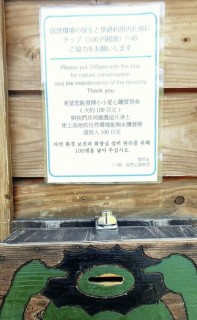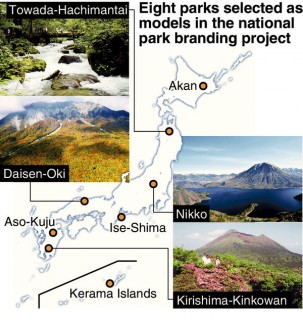Loading
Search
▼ Mountain Regions Work to Draw Foreigners
- Category:Tourism
KAMIKOCHI, Nagano — The inauguration of the nation’s newest national holiday — Mountain Day — on Aug. 11 reflects the government’s aim to promote Japan’s mountainous regions as international tourist sites.
Services for foreign tourists have been enriched in the Kamikochi highland district of Matsumoto, Nagano Prefecture, where a commemorative ceremony marking the new holiday was held. The ceremony was streamed to the world via the internet.
The government has also started to improve eight national parks with the aim of doubling the total number of foreign visitors to all national parks.
In the Kamikochi district, the clear Azusagawa river runs through the gateway to the Northern Japanese Alps. The scenic mountainous spot was “discovered” by a Westerner who brought modern mountain climbing to Japan during the Meiji era (1868-1912). In recent years, the number of foreign tourists visiting Kamikochi has been increasing.
When I visited Kamikochi at the end of July, there were not many Japanese visitors as it was the rainy season. But Europeans and Americans in trekking gear were conspicuous. Kamikochi’s image as an international tourist spot has become stronger, as reflected in the fact that signboards and instructions on how to use toilets are written in Japanese and foreign languages.
The number of foreign tourists staying in Kamikochi, most of whom are from other Asian countries, is increasing. In 2015, the number rose to about 8,900, more than double the number of about 3,800 in 2013.
In Nishiitoya Sanso, a long-established mountain lodge located near the Kappabashi bridge, foreign lodgers account for 30 percent of all lodgers. Japanese and English are written together in information posted inside the lodge, and the lodge accommodates dietary preferences and restrictions when it accepts reservations.
Services for foreign tourists have been enriched in the Kamikochi highland district of Matsumoto, Nagano Prefecture, where a commemorative ceremony marking the new holiday was held. The ceremony was streamed to the world via the internet.
The government has also started to improve eight national parks with the aim of doubling the total number of foreign visitors to all national parks.
In the Kamikochi district, the clear Azusagawa river runs through the gateway to the Northern Japanese Alps. The scenic mountainous spot was “discovered” by a Westerner who brought modern mountain climbing to Japan during the Meiji era (1868-1912). In recent years, the number of foreign tourists visiting Kamikochi has been increasing.
When I visited Kamikochi at the end of July, there were not many Japanese visitors as it was the rainy season. But Europeans and Americans in trekking gear were conspicuous. Kamikochi’s image as an international tourist spot has become stronger, as reflected in the fact that signboards and instructions on how to use toilets are written in Japanese and foreign languages.
The number of foreign tourists staying in Kamikochi, most of whom are from other Asian countries, is increasing. In 2015, the number rose to about 8,900, more than double the number of about 3,800 in 2013.
In Nishiitoya Sanso, a long-established mountain lodge located near the Kappabashi bridge, foreign lodgers account for 30 percent of all lodgers. Japanese and English are written together in information posted inside the lodge, and the lodge accommodates dietary preferences and restrictions when it accepts reservations.
Tsukasa Okuhara, the third-generation president of the lodge, who also serves as the president of Kamikochi Resort Hotel Association, said, “Kamikochi, in which mountains, forests and river are compactly concentrated, seems to fascinate foreign visitors as something other countries don’t have.”
The association redesigned its foreign-language website this summer to meet such foreigners’ needs. Information on the website includes the fact that Kamikochi is the southern gateway to Chubusangaku National Park. The website touts the charms of the local nature and culture, explains rules for preserving nature and lists trekking and walking routes.
Okuhara stressed the need for further improvement, saying, “To put Kamikochi on a par with mountainous tourist spots overseas, it’s necessary to prepare such conveniences as ATMs and fiber-optic internet access.”
During the Mountain Day commemorative ceremony to which representatives from the embassies of mountainous nations such as Switzerland and Nepal were invited, Nagano Gov. Shuichi Abe declared, “We’ll undertake our utmost efforts to make Nagano a mountainous prefecture beloved by people all over the world.”
On the previous day, an international symposium to discuss mountain tourism that can be enjoyed by various people, including foreign visitors and people with disabilities, was held in Nagano. The symposium took up such overseas cases as Britain’s footpaths, a national system of hiking routes that resembles mesh when shown on a map of Britain; U.S. national parks, which feature extensive visitor centers; and mountainous Swiss resorts, which seek to accommodate elderly visitors.
The government plans to expand its focus to the potentialities of all its mountainous tourist spots, promoting all its national parks as tourist attractions, including Fuji-Hakone-Izu National Park, which includes Mt. Fuji. The number of foreign visitors to the famous mountain rose to 2.34 million last year.
Learning from the example of Yellowstone National Park in the United States, which has abundant guided tours and accommodation facilities, the government plans to increase the number of annual foreign visitors to Japan’s 32 national parks to 10 million by 2020 from 4.3 million last year.
In July, the Environment Ministry selected eight of Japan’s national parks for a national park-branding project aimed at increasing foreign tourists.
The eight model parks include Aso-Kuju National Park in Kumamoto and Oita prefectures, which also have a Kumamoto Earthquake recovery aspect; Akan National Park, whose main city of Kushiro has been selected by the Tourism Agency as a model business center to attract foreigners; and Ise-Shima National Park, which has a comprehensive program for ecotourism.
An official in charge of national parks at the ministry explained why the eight national parks were chosen as model parks of the project, saying, “We gave a great deal of weight to the fact that the local governments had clear concepts [for attracting foreign visitors] and were enthusiastic.”
The association redesigned its foreign-language website this summer to meet such foreigners’ needs. Information on the website includes the fact that Kamikochi is the southern gateway to Chubusangaku National Park. The website touts the charms of the local nature and culture, explains rules for preserving nature and lists trekking and walking routes.
Okuhara stressed the need for further improvement, saying, “To put Kamikochi on a par with mountainous tourist spots overseas, it’s necessary to prepare such conveniences as ATMs and fiber-optic internet access.”
During the Mountain Day commemorative ceremony to which representatives from the embassies of mountainous nations such as Switzerland and Nepal were invited, Nagano Gov. Shuichi Abe declared, “We’ll undertake our utmost efforts to make Nagano a mountainous prefecture beloved by people all over the world.”
On the previous day, an international symposium to discuss mountain tourism that can be enjoyed by various people, including foreign visitors and people with disabilities, was held in Nagano. The symposium took up such overseas cases as Britain’s footpaths, a national system of hiking routes that resembles mesh when shown on a map of Britain; U.S. national parks, which feature extensive visitor centers; and mountainous Swiss resorts, which seek to accommodate elderly visitors.
The government plans to expand its focus to the potentialities of all its mountainous tourist spots, promoting all its national parks as tourist attractions, including Fuji-Hakone-Izu National Park, which includes Mt. Fuji. The number of foreign visitors to the famous mountain rose to 2.34 million last year.
Learning from the example of Yellowstone National Park in the United States, which has abundant guided tours and accommodation facilities, the government plans to increase the number of annual foreign visitors to Japan’s 32 national parks to 10 million by 2020 from 4.3 million last year.
In July, the Environment Ministry selected eight of Japan’s national parks for a national park-branding project aimed at increasing foreign tourists.
The eight model parks include Aso-Kuju National Park in Kumamoto and Oita prefectures, which also have a Kumamoto Earthquake recovery aspect; Akan National Park, whose main city of Kushiro has been selected by the Tourism Agency as a model business center to attract foreigners; and Ise-Shima National Park, which has a comprehensive program for ecotourism.
An official in charge of national parks at the ministry explained why the eight national parks were chosen as model parks of the project, saying, “We gave a great deal of weight to the fact that the local governments had clear concepts [for attracting foreign visitors] and were enthusiastic.”
The eight national parks will promote local efforts by creating regional councils comprising municipalities and private organizations. The councils will be tasked with rejuvenating national parks by flexibly making use of the private sector’s vitality to prepare visitor centers, cafes and tourist information centers.
Eight national parks in branding project with main reasons for selection
■ Aso-Kuju: recovery from Kumamoto Earthquake, caldera and long-preserved grassland
■ Akan: showcase of tourism-oriented nation, comprehensive ecotourism program
■ Towada-Hachimantai: recovery from Great East Japan Earthquake, hot spring culture
■ Nikko: success in attracting tourists from Western nations
■ Ise-Shima: traditional culture, comprehensive ecotourism program
■ Daisen-Oki: advanced efforts for sustainable use
■ Kirishima-Kinkowan: diverse volcanoes, Kirishima-centered collaboration among municipal governments
■ Kerama Islands: efforts to preserve coral reefs
Eight national parks in branding project with main reasons for selection
■ Aso-Kuju: recovery from Kumamoto Earthquake, caldera and long-preserved grassland
■ Akan: showcase of tourism-oriented nation, comprehensive ecotourism program
■ Towada-Hachimantai: recovery from Great East Japan Earthquake, hot spring culture
■ Nikko: success in attracting tourists from Western nations
■ Ise-Shima: traditional culture, comprehensive ecotourism program
■ Daisen-Oki: advanced efforts for sustainable use
■ Kirishima-Kinkowan: diverse volcanoes, Kirishima-centered collaboration among municipal governments
■ Kerama Islands: efforts to preserve coral reefs
- September 16, 2016
- Comment (0)
- Trackback(0)




